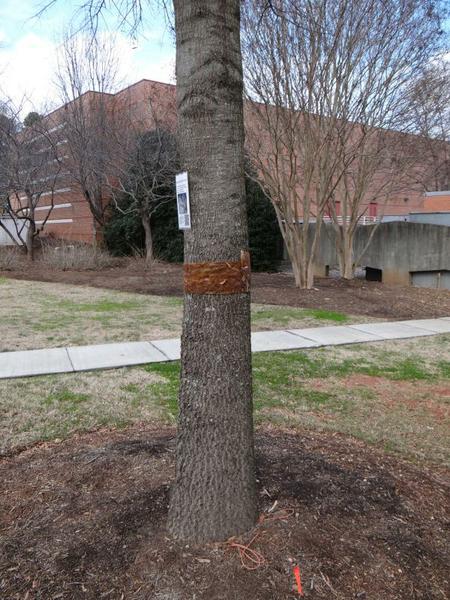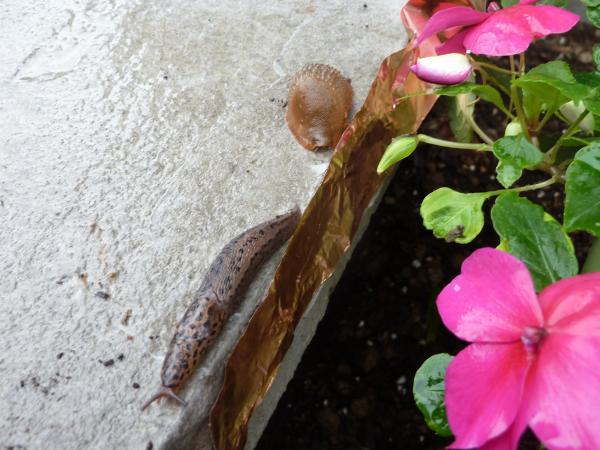Outline
Principles of Organic Gardening
Organic and Inorganic (Mineral) Soil Amendments
Weeds as Indicators of Soil Condition
Objectives
This chapter teaches people to:
- Understand organic gardening principles
- Define organic gardening as a systematic approach, rather than the simple substitution of organic products for synthetics
- Implement organic strategies for dealing with pests, diseases, and weeds
Introduction
Interest in home gardening, sustainable use of natural resources, and organic practices continues to rise with increasing concern about the health and safety of families, pets, and the environment. Generally, organic gardeners focus on practices that enhance soil health and plant nutrition, as well as suppress weeds. Organic gardeners manage weeds and other pests (including disease organisms) without the use of synthetic fertilizers or pesticides. Organic and conventional gardening share many similarities, so other chapters in this manual provide more in-depth information on many of the topics included here.
The definition of organic methods varies because there is no organic gardening standard for home gardens. Certified organic farmers must meet the U.S. Department of Agriculture’s National Organic Program (NOP) Organic Standards and use the National List of Allowed and Prohibited Substances. The Organic Materials Review Institute (OMRI) is a nonprofit organization that provides professional, independent reviews of materials and processes for suitability in organic food and fiber production (Figure 17–1). Home gardeners can consult the OMRI Products List© to find products that OMRI has determined are allowed for use under NOP organic standards.
History
Organic gardening began in 1940s wartime England when Lord Walter Northbourne coined the phrase “organic farming” in his book, Look to the Land. Publication of Sir Albert Howard’s An Agricultural Testament and Lady Eve Balfour’s The Living Soil during the same decade inspired J.I. Rodale, who popularized organic gardening in the United States (Figure 17–2). Rodale’s books and magazines promoted the theory that we must restore and protect soil health to preserve and improve human health.
In 1962, Rachel Carson’s book Silent Spring increased public awareness of the impact of pesticides such as DDT on nontargeted organisms, including birds, fish, mammals, and beneficial insects. During the 1970s and 1980s, increasing concerns about industrial agricultural practices led to interest in “alternative agriculture.” By the end of the 1980s, the phrase “sustainable agriculture” came into popular use to describe a movement to restore the ecology in socially responsible, economically viable ways.
Principles of Organic Gardening
Organic gardeners generally subscribe to the following principles, each of which will be discussed in greater detail in subsequent sections of this chapter:
- A strong emphasis on building healthy garden soil, which has a diverse microbial population, adequate organic matter, proper pH, and good fertility
- Building a nutrient reservoir into the soil, as opposed to relying heavily on fertilizer applications
- A holistic approach to pest management
- Use of only naturally-derived fertilizers and pest control products, and using them sparingly
Soil Management and Fertility
Rather than a traditional approach of applying fertilizers to feed plants, the foundation of successful organic gardening is building healthy soils. Healthy organic garden soils have a strong nutrient reservoir and proper pH for plant growth, which are provided by adding organic matter rather than traditional fertilizers. Refer to chapter 1, “Soils and Plant Nutrients,” and chapter 2, “Composting,” for more in-depth information.
Organic and Inorganic (Mineral) Soil Amendments
Soil amendments are used to improve soil health and condition. Incorporating organic matter into tight clay, for example, lowers soil bulk density, creates pore spaces for air and water, and improves soil structure and tilth, allowing expansion of roots. Adding organic matter to sandy soil improves water-holding and nutrient-holding capacity, feeds soil microbes, and improves soil structure.
In the warmer North Carolina piedmont and coastal plain, higher temperatures lead to faster rates of decomposition, and soils can require up to twice as much organic material compared to cooler environments. If practical, it is a good idea to mulch areas after adding organic matter. Mulch is material layered over the soil surface to reduce evaporation and keep roots cool. Mulch also reduces weed emergence, soil compaction, and erosion. In the case of plant-based mulches, the addition of mulch further contributes to soil organic matter content.
Many organic and inorganic, or mineral, materials increase a soil’s pore space or improve water-holding capacity. Most of the amendments listed in Table 17–1 will improve a clay or sandy soil. Peat and sand, however, are two amendments that warrant caution. As the product of wetland ecosystems, sphagnum peat and sedge peat are not renewable at the current rate harvested to satisfy horticultural market demands. Coir dust, derived from coconut husks, may be a more sustainable alternative to peat, and more consistent in pH and quality (Figure 17–3). Coir dust performs better in light, sandy soils where its moisture retention qualities are appreciated. Like peat, however, coir may overwhelm clay soils, making a saturated native soil even stickier.
Heavy clay soils always benefit from the addition of compost. Fine sand is not recommended as a clay conditioner because small clay particles mixing with fine sand particles cause compaction and a loss of aeration, resulting in a concrete-like soil. For heavy clay, rocky, poorly drained, or contaminated soils, create raised beds.
Table 17–1. Soil amendments and mulch a
| Organic | |
|---|---|
| Chopped straw | Green manures |
| Coir dust | Leaf mulch |
| Composted fruit wastes | Municipal compost |
| Composted kitchen scraps | Peanut hulls |
| Composted manure | Pecan hulls |
| Composted sawdust | Pine bark (¼”–½” pieces) |
| Composted seaweed | Pine straw |
| Composted wood chips | Shredded newspaper |
| Corn cobs | Vermicompost |
| Cotton gin compost | Yard waste |
| Mineral | |
| Agricultural-grade expanded shale | Medium or coarse sand |
| Gravel (pea-sized) | Perlite |
| Gypsum | Vermiculite |
| a Starbuck, Christopher J. 2008. Mulches. G6960. Columbia, MO: University of Missouri Extension. | |
Fertility Management
Rather than relying primarily on applied fertilizers, many organic gardeners seek to build a nutrient reservoir in the soil through the periodic addition of organic soil amendments and the use of green manures (cover crops that are incorporated back into the bed). As with any gardening project, start with a soil analysis to determine initial nutrient and pH levels, and monitor with follow-up sampling at least every three years.
Organic Fertilizers
Use organic materials listed in Table 17–2 to address soil test recommendations. Note that some materials are not allowed by OMRI for use as crop fertilizers, but may be considered for household use. Nutrients listed are averages. Because nutrient composition of animal manures and composts vary widely, send a sample to the NC Department of Agriculture & Consumer Services, Agronomic Division, for nutrient analysis before use.
Herbicide Carryover
Some gardeners have seen damage to their plants or crops after the application of hay, manure, compost, or grass clippings. This is due in part to the persistence of some herbicides that were used on the plant materials before they became mulch. It is important to know the source and chemical history of any green material before it is used in the garden. Learn more in the NC State Extension publication Herbicide Carryover in Hay, Manure, Compost, and Grass Clippings.
Table 17–2. Organic fertilizersabc.
Items below are generally acceptable under the NOP for commercial organic farmers, unless otherwise noted.
| Fertilizer | Primary Benefit | Average Analysis | Notes |
|---|---|---|---|
| Alfalfa meal | Organic matter | 5–1–2 | Contains triacontanol, a natural fatty acid growth stimulant, and trace minerals. |
| Algae | Organic matter | N/A | Includes photosynthetic organisms of the Kingdom Protista typically found in aquatic or shoreline environments. Algae do not have true roots, stems, or leaves. Organic Materials Review Institute (OMRI) approved. |
| Amino acid (nonsynthetic) | Chelating agent | N/A | A chelating agent improves plant uptake of a nutrient. Also used as a plant growth regulator. |
| Ash | Liming effect, source of calcium, micronutrients | 25% calcium carbonate; 9% potash | Ash from plant or animal sources only. Ashes from burning minerals, manure, or other substances are prohibited. |
| Basalt dust | Micronutrients | N/A | Improves cation exchange capacity. |
| Blood meal (dried) | Nitrogen | 10–0–0 | Dried blood collected from slaughtered animals. One of the highest non-synthetic forms of nitrogen. Over-application can burn plants with too much ammonia. |
| Bone meal (steamed) | Phosphate | 3–15–0; 20% total phosphate; 24% calcium | Ground animal bones that have been steamed under pressure, heated, or rendered sterile. Bone meal phosphorus is only plant-available in soils lower than pH 7. Widely available at feed stores. |
| Borax | Trace minerals | 10% boron | Also known as sodium tetraborate. |
| Calcitic limestone | Calcium | 65%–80% calcium carbonate | Mined calcium carbonate. |
| Coffee grounds | Nitrogen | 2–0.3–0.2 | Acid-forming soil amendment. Needs limestone supplement. |
| Colloidal phosphate | Phosphate | 0–2–2 | |
| Compost (commercial or homemade) | Organic matter | Varies with components added | The product of a managed process through which microorganisms break down plant and animal materials into plant-available soil nutrients. Composted materials produced in vessels or static aerated piles must be maintained at a temperature between 131° F to 170° F for three days. Windrow systems must maintain at the above temperature for 15 days and turned at least five times. NCDA&CS waste analysis recommended if fertilizer content unknown. |
| Corn gluten meal | Nitrogen | 9–0–0 | Allelopathic properties may inhibit seed germination for one to four months, however there is no danger to established or transplanted plants; can reduce weed seed germination. Cannot come from genetically modified corn. |
| Cottonseed meal | Nitrogen | 6–4–1.5 | Cannot come from genetically modified cotton. Must be free of prohibited pesticide residues. |
| Cotton gin trash | Nitrogen, phosphorus, potash | 14–10.5–41 | Cannot come from genetically modified cotton. Must be free from prohibited residues. |
| Dolomite (mined or fired) | Balancer, calcium, magnesium | 51% calcium carbonate; 40% magnesium carbonate | May cause buildup of magnesium. |
| Eggshell meal | Calcium | 1.2–0.4–0.1 | Contains trace minerals. |
| Elemental sulfur | Balancer, nutrient | 99.5% sulfur | Used as a fertilizer and soil amendment. Not plant-available until soil bacteria oxidize it to the sulfate form. OMRI restricts use, but does not prohibit. |
| Epsom salts | Balancer, magnesium | 10% magnesium; 13% sulfur | Also known as mined magnesium sulfate or kieserite. |
| Feather meal | Nitrogen | 11–0–0 | Slow-release nitrogen source. |
| Fish emulsion | Nitrogen | 5–2–2 | Contains 5% sulfur. Foul odor. Emulsions are soluble liquid fertilizers. |
| Fish meal | Nitrogen | 10–6–2 | Ground and heated-dried fish waste. Includes cannery waste and pomaces. |
| Fish powder | Nitrogen | 12–0.25–1 | Heat dried into a water-soluble powder. Can be injected into an irrigation system for immediate to 1-month release. |
| Fur | Nitrogen | 12–0–0 | |
| Granite dust | Potash | 4% potash | Contains 67% silicas and 19 trace minerals. Cannot use sources mixed with petroleum products such as from stone engraving. |
| Greensand | Potash | 7% total potash | Glauconite. Contains trace minerals. |
| Gypsum, mined | Calcium, balancer | 22% calcium; 17% sulfur | Also known as calcium sulfate. Do not apply for pH < 5.8. OMRI-approved, but prohibits Gypsum produced as a manufacturing byproduct. |
| Hair | Nitrogen | 12%–16% nitrogen | |
| Hoof and horn meal | Nitrogen | 12–2–0 | Slow-release nitrogen source. |
| Horse manure | Organic matter | 1.7–0.7–1.8 | Be sure that manure is composted when applied to plants for human consumption to prevent burning plants and cross-contamination of edible portions by pathogens. OMRI restricts, but does not prohibit, animal manure. |
| Kelp meal | Potash | 1.5–0.5–2.5; trace minerals | Dried marine algae derived from the botanical divisions of Rhodophyta (red algae), Phaeophyta (brown algae), and Chlorophyta (green algae). Combined with fishmeal to provide NPK. |
| Leaf mulch | Organic matter | 0.5–0.1–0.5 | Uncomposted plant material. |
| Magnesium rock | Magnesium | 32%–35% magnesium | Mined substance. |
| Milk | Nitrogen | 0.5–0.3–0.2 | Dry and liquid forms. |
| Oyster shells | Calcium | 33.5% calcium | Also known as oyster shell lime from ground shells. |
| Peanut meal | Nitrogen | 7.2–1.5–1.2 | |
| Peat moss | Organic matter | pH range 3.0–4.5 | Use around acid-loving plants. Must not contain synthetic wetting agents. |
| Potassium sulfate | Potassium, sulfur | 22% potash; 23% sulfate | Langbeinite or non-synthetic sources. |
| Poultry manure | Organic matter | 4–4–2 | Be sure that manure is composted when applied to plants for human consumption to prevent burning plants and cross-contamination of edible portions by pathogens. |
| Rabbit manure | Organic matter | 1.5–1–1 | Be sure that manure is composted when applied to plants for human consumption to prevent burning plants and cross-contamination of edible portions by pathogens. |
| Rock phosphate | Phosphate | 0–3–0 | Source of slow-release phosphate. Contains trace minerals and 32% calcium. |
| Sawdust (untreated) | Organic matter | 0.2–0–0.2 | Be sure sawdust is well composted before incorporating. Untreated, unpainted wood only. |
| Sheep manure | Organic matter | 4–1.4–3.5 | Be sure that manure is composted when applied to plants for human consumption to prevent burning plants and cross-contamination of edible portions by pathogens. |
| Soybean meal | Nitrogen | 7–0.5–2.3 | Not OMRI approved. |
| Straw | Nitrogen, potash | 0.2–0–0.2 | May be from nonorganic sources. Must be from non-genetically modified plants. |
| Sulfur | Sulfur | 50%–100% sulfur | Can be used to lower pH. Elemental sulfur. |
| Sul-Po-Mag | Potash, magnesium | 0–0–22; 11% magnesium; 22% sulfur | Do not use if applying dolomitic limestone. Substitute greensand or other potassium source. Sul-Po-Mag from langbeinite or other nonsynthetic mineral sources. |
| Wood ashes | Potash, micronutrients | 0–2–6 | Do not use ash from colored paper, plastic, or other prohibited materials. Ashes derived from coal, cardboard, household trash, or stained, painted or treated woods contain elements toxic to plant growth. Do not use ash on acid-loving plants or tender seedlings.d Apply no more than 20 lbs. per 100 square feet annually. May be used to temporarily repel slugs and snails.e |
| Wood chips | Phosphorus | 0–0.4–0.2 | From untreated, unpainted materials. |
| Worm castings | Organic matter | 0.5–0.5–0.3 | 50% organic matter, plus trace minerals. Must be made from feedstock; no raw manure feedstock or synthetic feedstock.f |
| a Zublena, J.P., J.V. Baird, and J. P. Lilly. 1991. SoilFacts: Nutrient content of fertilizer and organic materials (AG-439-18). Raleigh, NC: North Carolina Cooperative Extension Service. b Carr, P.M., G.R. Carlson, J.S. Jacobsen, G.A. Nielson, and E.O. Skogley. 1991. Farming soils, not fields: A strategy for increasing fertilizer profitability. Journal of Production Agriculture, 4(1): 57-61. Madison, WI: American Society of Agronomy, Crop Science Society of America, Soil Science Society of America. c Items listed are generally acceptable under the National Organic Program for commercial organic farmers, unless otherwise noted. d Herring, Peg. 2011 Jan 1. Use caution with wood ash on your lawn and garden. Corvallis, OR: Oregon State University Extension Service. e Lerner, B. Rosie. 2006, April 10. Wood ash in the garden. LaFayette, IN: Purdue University Consumer Horticulture, Department of Horticulture and Landscape Architecture. f For information regarding other benefits of worm castings, see the NC State University website for vermicomposting in North Carolina. |
|||
Weeds as Indicators of Soil Condition
As you refine your observation skills regarding soil type and quality, you may be able to identify soil conditions and estimate soil pH by the plants growing in it. Weed seeds prosper in niches with the light, water, and soil conditions that each weed prefers. The presence of some weeds can indicate certain soil conditions (Figure 17–4). Table 17–3 includes information on some weeds’ preferred soil conditions.
Table 17–3. Soil Indicator weeds.
| Soil Condition | Weeds |
|---|---|
| Dry soil | Prostrate and spotted spurge, black medic, yellow woodsorrel, goosegrass, mustards, annual lespedeza, birdsfoot trefoil, prostrate knotweed, bracted plantain, silvery cinquefoil, yarrow |
| Wet soil | Moneywort, annual bluegrass, alligatorweed, pearlwort, moss, liverwort, rushes, sedges, plantains, oxeye daisy, meadowsweet, docks, coltsfoot, kyllinga, goosegrass, algae, henbit, woodsorrel, dollarweed |
| Compacted or clay soil | Annual bluegrass, annual sedge, annual lespedeza, broadleaf plantain, corn speedwell, goosegrass, prostrate knotweed, prostrate and spotted spurge, common sow thistle, quackgrass, plantain, pennycress, mustards, dandelion, coltsfoot, chickweed |
| Light or sandy soil | Common sheep sorrel, horsetail, field bindweed, sandspur, poorjoe, quackgrass |
| Low fertility | Birdsfoot trefoil, broomsedge, hawkweed, moss, legumes (clover spp., chickweed, speedwell spp., black medic, chicory), bitter sneezeweed, crabgrass, common mullein, yarrow |
| High fertility | Annual bluegrass, chickweed, ryegrass, pigweed, lamb’s quarter, moss |
| Acid soil | Silvery cinquefoil, common sheep sorrel, red sorrel, plantain, oxeye daisy, nettles, common mullein, moss, knotweed, horsetail, docks, coltsfoot |
| Alkaline soil | Pennycress, broad plantain |
| Saline soil | Shepherd’s purse |
| Plant-parasitic nematodes | Prostrate knotweed, spotted spurge, Florida pusley, sedges |
Cover Crops and Green Manures
Cover crops, or green manures, are plants grown specifically for incorporation into the soil to improve fertility and add organic matter, which in turn improves soil structure. Cover crops reduce erosion, suppress weeds, and aerate compacted soils. It is common to combine cover crops such as rye and vetch in the winter with soybean and pearl millet in the summer (Figure 17–5). Examples of common cover crops are found in Tables 17–4 and 17–5.
Table 17–4. Winter cover crops for North Carolina (Evans, 2012; Hamilton, 2005).
| Crop | Planting and Growth | Seeding Rate | Comments |
|---|---|---|---|
| Austrian winter pea (legume) | Sow Sept – Oct | 1 lb. per 1,000 ft2 | Grows well in combination with oats, barley, rye, or wheat. Decomposes quickly, therefore not a good choice as surface mulch. Unreliable growth in western half of NC. |
| Barley | Sow Aug – Oct | 4 – 6 lb. per 1,000 ft2 | Typically planted as a smother crop to suppress winter annuals. |
| Crimson clover (legume) | Sow Sept – Nov | ½ – 1 lb. per 1,000 ft2 | Can be seeded into fall vegetable crops. |
| Rye | Sow Sept – Oct | 2 – 3 lb. per 1,000 ft2 | Good nitrogen scavenger. |
| Ryegrass | Sow Sept – Nov | 1 lb. per 1,000 ft2 | High water and nitrogen needs. |
| Triticale | Mid Aug – Early Dec | 2.5 lb. per 1,000 ft2 | Can be grown earlier than wheat to produce more winter growth. |
| Hairy vetch | Sow Sept – Nov | 12 oz. per 1,000 ft2 | Does well planted in combination with grasses. Easily killed in mid-bloom by mowing. |
| Wheat | Late Sept – Early Dec | 2.75 lb. per 1,000 ft2 | Can also be seeded in April to be incorporated as a green manure. |
Table 17–5. Summer cover crops for North Carolina (Evans, 2012; Hamilton, 2005).
| Crop | Planting and Growth | Seeding Rate | Comments |
|---|---|---|---|
| Buckwheat | Spring, summer, fall | 1.5 lb. per 1,000 ft2 | Frost sensitive. Effective phosphorus scavenger. Decomposes rapidly. Do not allow it to go to seed. |
| Seed formation four – six weeks | |||
| German (foxtail) millet | Mid May – Aug. | 11 oz. per 1,000 ft2 | Small-seeded grass crop. Best if planted in stale seedbed. Avoid coarse sands. |
| Seed formation 75 – 90 days | |||
| Japanese millet | April – July | 11 oz. per 1,000 ft2 | Rapid growth. Does not perform well in sandy soils. |
| Seed formation around 45 days | |||
| Oats | Spring and Fall | 3 – 4 lb. per 1,000 ft2 | Provides rapid groundcover. Fall planted oats will be winter killed. |
| Pearl millet | April – July | 11 oz. per 1,000 ft2 | Summer annual bunchgrass. Grows well in sandy loam or poor, sandy soils. |
| Seed formation around 60 – 70 days | |||
| Sorghum-Sudangrass | Mid May – July | 1 lb. per 1,000 ft2 | Plant in mixtures to support climbing legumes like velvetbean. Scavenges nitrogen. Mowing at 3” promotes root growth. |
| Frequent mowing prevents seeding | |||
| Southern peas (legume) | May – Aug. | 2 – 4 lb. per 1,000 ft2 | Also known as cowpeas, blackeye, and crowder peas. Wide soil and drought tolerance. |
| Seed formation around 60 days | |||
| Soybeans (legume) | April – June | 2 lb. per 1,000 ft2 | Will grow on nearly all soils. Late-maturing varieties generate more biomass and fix more nitrogen. Inexpensive choice. |
| Seed formation around 90 days | |||
| Velvetbean (legume) | May – June | 1 lb. per 1,000 ft2 | Does well in poor, sandy soils. Can be planted with sorghum-sudangrass. Good green manure crop. |
| Seed formation around 100 days |
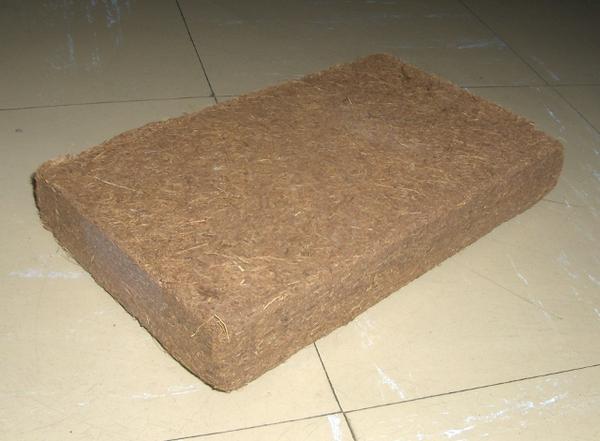
Figure 17–3. Coconut husk coir can be used as a soil amendment as a replacement for sphagnum peat moss.
Matis Miika, Wikimedia CC BY 2.0

Figure 17–5. A cover crop of clover in this vegetable garden provides nutrients to the soil when it is tilled under.
Graibeard, Flickr CC BY-SA 4.0
Pest Management
Organic gardeners rely on methods other than synthetic pesticides to manage weed, insect, and disease pests. Organic gardening, however, is more than simply substituting a naturally derived pesticide for a synthetic one. Organic gardeners must take a holistic approach to pest management and focus on using all available methods to support plant health, including good fertility, proper irrigation, crop rotation, conserving beneficial insects, and mulching. This approach requires the extensive use of integrated pest management strategies (refer to chapter 8, “IPM,” for more information). Even those who do not strictly follow organic gardening practices benefit from following this holistic approach. Organic pesticides should be handled with the same care and caution as synthetic pesticides because even naturally derived products may pose risks to health and the environment.
Weed Management
Weeds are a mixed aspect of the landscape. Weeds compete with desirable plants for water, nutrients, and sunlight. Some harbor insect pests and diseases, cause allergies, or are poisonous. Nevertheless, weeds also make many positive contributions. Weeds are indicators of soil problems, such as compaction. Weeds return nutrients to the soil when pulled and composted, and weed roots can help break up compacted soil. Weeds provide habitat, shelter, pollen, and nectar for beneficial organisms, such as spiders (Figure 17–6), praying mantises (Figure 17–7), beetles (Figure 17–8), predatory wasps (Figure 17–9), syrphid flies (Figure 17–10), and bees (Figure 17–11). Many weeds are edible, such as the greens from chickweed, cress, dandelion, lamb’s quarters, mustard, and purslane. Some weeds serve as “trap crops” that lure insect pests away from desirable plants (Figure 17–12). It may be advantageous to permit certain weeds during the season, but prevent them from going to seed. As you learn more about the different weed species and the benefits of having some weeds in your garden, you may even learn to regard some of them as allies to promote soil and plant health. Weed management is most effective if you know what species of weed you are fighting and how it spreads, so proper identification is important. See chapter 6, “Weeds,” for further information on identification and management strategies.
Tillage and Mechanical Management
Repeated cultivation with hand tools or powered tillage equipment is very effective on many annuals and biennial weeds, but less so on many perennial weeds. Many perennial weeds have underground structures such as tubers and rhizomes that allow the weeds to regrow (Figure 17–13). Such structures are easily spread to new areas if tillage equipment is not cleaned after use. Most perennial weeds are well-managed in small gardens, ornamental beds, and turf by hand-pulling or digging the roots out and removing new sprouts. Larger areas may require hoe or rotary cultivation. Take care when using these tools to avoid damaging the roots of nearby desirable plants.
Cultivation is best done one or two days after watering when the soil is still damp, but not wet. Working wet soil degrades soil structure, especially that of heavy soils. When the soil is too dry, weeds are hard to pull and hoeing is difficult. Weeds that have been pulled, but have not yet gone to seed, can be used to return organic matter to the soil. Hand-pulled weeds may be laid on top of the soil to dry out, with the exception of rhizomatous grasses, such as Kentucky bluegrass, Canada bluegrass, and creeping red fescue. Succulent weeds, such as purslane, and weeds that have gone to seed, which may inadvertently reestablish, should be completely removed from the garden. Reducing weed growth in the surrounding yard by mowing or other means also helps prevent the spread of weeds in the garden.
Hand-pulling
Pulling weeds by hand is a necessary part of maintaining any garden, organic or not. As with tillage, pulling weeds is easiest when the soil is slightly moist and when the weeds are young and small. Scouting beds on a weekly basis makes this routine chore easier.
Mulch
Organic mulch prevents most annual weeds. Applied annually in late winter before deciduous plants leaf out and before summer annual weeds germinate, mulch covers winter weeds, suppresses germination of summer annual weeds, holds soil moisture, and improves aesthetics. For best results, remove existing weeds before applying the mulch.
Select the type of mulch based on availability, cost, aesthetics, and personal preference. Examples include shredded hardwood, pine straw, pine bark, and cedar. Maximum weed management benefits can be seen with 3 inches to 4 inches of organic mulch. In general, 1 cubic yard covers 100 square feet to a depth of 3 inches.
These are suggested mulch depths:
- 3 inches for woody and perennial landscape beds
- About 1 inch of mulch on annual color beds—just enough to cover the surface
Materials such as newspaper or cardboard that are covered with an attractive mulch (such as pine bark, shredded hardwood, or pine straw) provide excellent weed suppression (Figure 17–14). Some gardeners use living grass as a weed barrier between raised beds. Fescue works well because it does not spread into adjacent beds (Figure 17–15).
Cover Crops
Planting cover crops, also called green manures, is another effective strategy for weed management (Table 17–4). Oats, a widely grown cereal grass, is a winter cover crop (Table 17–5) that does not pose a weed problem upon maturation (Figure 17–16). Left over the winter, winter-killed oat grass creates a thick mat of mulch that prevents soil erosion and suppresses late-fall and early-spring weeds. Rye is a good winter cover crop for late-season plantings. Rye typically establishes better than wheat and is thought to be allelopathic, inhibiting the growth of other plant species.
Green manures are also used as living mulches, meaning that they are planted among crops where they help to fill the open spaces, reduce weeds and erosion, and conserve water. For example, late-season broccoli benefits from underseeding with a winter-hardy legume like hairy vetch. To do this, maintain a weedfree seedbed for one month after the broccoli is planted by cultivating or pulling weeds in and between rows, being careful not to disturb the roots of your garden plants. When plants are 6 inches to 8 inches tall, spread the mulch crop seed over the entire area. By the time the broccoli is ready for harvest, the vetch can be walked on without being damaged. Turn under the vetch several weeks before planting the following spring so that the vetch does not go to seed and become a weed itself.
Thermal
Thermal weed management, using either flame weeders or hot water, is most effective on young broadleaf weeds that are 1 inch to 2 inches tall. Perennial weeds and grasses may require repeat treatments. Hand-held propane gas burners, which produce a carefully controlled and directed flame, sear leaves, causing the plant to wilt and die (Figure 17–17). High temperature water or steam eliminates the hazard of flame application. It is possible for hot water to infiltrate to the roots or move across the soil surface, so only use it in open areas where there is less contact with roots and crowns of desirable plants.
Spacing
Spacing of vegetable garden plants is an effective weed suppression tool. Establish transplants or plant seeds close together so that a foliar canopy quickly develops (Figure 17–18). This shades the soil and prevents the growth of many weed seedlings, giving crop plants a head start. As vegetable plants become larger and require more room, they can be thinned to maintain the canopy and plant health. Note that excessively close spacing reduces yields and increases insect and disease pressure.
Organic Herbicides
Vinegar (acetic acid), salts of fatty acids, the soap-based herbicide ammonium nonanoate, lemongrass oil, eugenol oil (clove oil), cinnamon oil, and corn gluten are examples of chemical organic weed managment.
Organic pest management places an emphasis on biodiversity and optimal growing conditions to build the garden’s natural resistance to pests. Enhancing habitat attracts and sustains beneficial organisms in the garden. Pest problems in the garden and landscape may indicate less than optimal growing conditions or an ecological imbalance. However, some familiar pathogens, such as tomato early blight (Figure 17–19), that spread by insects, irrigation, or garden tools, may always be a threat in North Carolina.
Insect Management
See chapter 8, “IPM,” for more information.
Ways That Home Gardeners Deviate From the NOP Rules for Commercial Production and Sales
Although commercial growers who wish to sell produce labeled as “organic” are under strict guidelines and require third-party certification, home gardeners are not regulated and have more flexibility. For example, most home gardeners do not keep the extensive records that commercial organic growers must maintain.
Here are some other differences between certified commercial organic growers and home organic gardeners:
- Seed purchases. The NOP requires organic farmers to purchase organic seed when available (Figure 17–20). There is no evidence that organic seed is any better than conventional seed. The current rules probably originated as a way to support the organic industry. So some gardeners buy nonorganic seed. Gardeners should make sure, however, that the seed has not undergone synthetic seed treatment or been pelletized with nonapproved seed coats.
- Transplant purchases. The NOP requires commercial farmers to purchase or grow certified organic transplants. This insures that no synthetic pesticides, synthetic fertilizer, or unapproved wetting agent comes in contact with the transplant. (Although unapproved, the wetting agent frequently used is a product of the yucca plant and is acceptable to some gardeners.) Organic transplants are sometimes hard for home gardeners to find and can be expensive. Some transplants may have been grown without synthetic pesticides, fertilizers, or wetting agents, but simply have not been certified.
- Manures. The NOP requires manure on organic farms to be applied no later than 120 days before harvest. Conventional farms require only 90 days between manure application and crop harvest to reduce pathogens. There is no scientific support for the 120 days, and that length of time may have been chosen simply because it was longer than the length of time used by conventional growers. A 90-day period between manure application and crop harvest may be acceptable to some home gardeners.
- Compost. The NOP requires compost to meet strict criteria, including temperature guidelines. Home-produced compost does not meet NOP guidelines, but most organic gardeners consider home-produced compost acceptable to use.
- Genetically modified organisms. The NOP contains rules prohibiting the use of genetically engineered crops, or materials derived from such crops. Very few genetically engineered crops are available for home gardeners, so this is rarely a consideration in home gardens.
In summary, home organic gardeners are not certified and so are not required to adhere to the NOP guidelines. Many gardeners fall somewhere on the spectrum between conventional gardening and organic gardening.
Take note of the insect pests you have struggled with in the past and concentrate on techniques to manage those. Be aware of recent climatic conditions. For example, Colorado potato beetles may be more numerous after a mild winter (Figure 17–21). Unusually wet springs favor slugs (Figure 17–22), and dry summers favor spider mites.
For more information on insect identification, please refer to chapter 4, “Insects.”
The integration of cultural, biological, physical, and chemical management methods help prevent many problems from becoming serious enough to affect plants or yields.
Cultural management. Emphasize plant health. That is the basis for cultural management, which relies on inexpensive measures to prevent infestations. This includes choosing well-adapted cultivars with insect and disease resistance, choosing the proper planting location, planting seeds or transplants during the weak point of a pest’s life cycle, and practicing good garden sanitation. Other cultural management strategies include managing soil fertility, cultivating and hand-pulling to manage weeds, and mulching to reduce pests.
Biological management. Blend natural defenses into your management plan. One example is parasitic wasps, which seek host insects for larval development (Figure 17–23). It is possible to enhance the habitat for beneficial insects so they do much of the pest management for you. Learn more about the beneficial insects you want to attract, the plants they prefer, and their life-cycle needs as they emerge and scout for prey. Be aware that microbial sprays also negatively affect some beneficial insects.
Physical management. Physical management strategies include basic handpicking (Figure 17–24), water sprays (Figure 17–25), floating row covers (Figure 17–26), tree bands (Figure 17–27), cutworm collars (Figure 17–28), and diatomaceous earth (Figure 17–29). Copper strips (Figure 17–30), sticky traps (Figure 17–31), wrapping fruit in cloth or paper bags (Figure 17–32), wrapping stems in fabric or foil ( Figure 17–33), covering fruit in kaolin clay (Figure 17–34), and pheromone traps (Figure 17–35) are other types of physical barriers. Pheromone traps are not effective at significantly reducing larval populations but may be helpful in monitoring movements of adult insects. Place pheromone traps far away from the garden to avoid luring pests into the garden.
Chemical management. All pesticides are chemical (whether they are categorized as botanical, inorganic, microbial, or petroleum-based). Chemical controls can be integrated into a management plan if garden pests are out of balance and overwhelming other management options.
There are three categories of approved organic pesticides of natural origin:
- Plant-derived products that contain the active ingredients pyrethrin, rotenone, nicotine, or other botanical chemicals
- Inorganic products, such as sulfur, copper, diatomaceous earth, kaolin clay, and boric acid
- Microbial products, such as beneficial nematodes, Bacillus thuringiensis, and spinosad
In addition, OMRI lists a select few synthetic pesticide products derived from fatty acids of potassium salts, such as insecticidal soap, and petroleum-based horticultural and dormant oils, used to smother scale and other soft-bodied insects. Horticultural oil in combination with bicarbonate salts, such as baking soda, may also be used to prevent powdery mildew on crops such as cucurbits.
Organic pesticides are not necessarily safer than synthetic insecticides, either to the user or the environment. For instance, products containing rotenone or pyrethrins are extremely toxic to fish. Insecticidal soaps are phytotoxic to some crops, and many organic pesticides are harmful to some beneficial insects. All pesticides, natural or synthetic, are toxins designed to kill pests, and should be treated as poisons. Read the label carefully and use the product only as directed.
Disease Management
Prevention is the key strategy for managing diseases in an organic garden:
- Select disease-free plants and disease-resistant cultivars.
- Select varieties that have been grafted onto disease-resistant rootstock.
- Practice garden sanitation.
- Wash hands after working with soils or plant material.
- Do not transfer garden soil from other gardens.
- Dispose of infected plants.
- Sterilize tools with a non-bleach household disinfectant product.
- Avoid wounding plants. Wounds create entryways for pathogens.
- Maintain vigorous plants.
- Thin plants when they become crowded.
- Practice crop rotation. Rotate crop families so that they are planted in the same plot no more than once every three years.
- Avoid working around wet plants, which favors spread of pathogens.
- Water plants in the morning versus other times of the day.
- Use physical strategies.
- Burn, bury, or dispose of, but do not compost, diseased plant residues.
- Solarize soil.
- Protect plants with row covers.
- Prune and remove diseased plant parts.
OMRI
The Organic Materials Review Institute (OMRI) is a nonprofit organization that provides independent reviews of products based on organic standards. It provides the results for organic certifiers, growers, manufacturers, and suppliers. If the products pass the review, they are OMRI Listed®. OMRI also provides technical support and training for professionals.
Organic fungicides
Occasionally cultural practices are not enough, especially with fungal diseases, and a preventive chemical is necessary. Sulfur, copper sulfate, and lime-sulfur are OMRI allowed for the following fungal diseases: rusts, black spot on roses, and powdery mildew. Bordeaux mixture is not allowed by OMRI because it contains hydrated lime, in addition to copper sulfate.
One tablespoon of baking soda plus 1 tablespoon of summer horticultural oil mixed with a gallon of water prevents the following fungal diseases: black spot, powdery mildew, botrytis, alternaria leaf spot, and many others. The oil acts as a sticker-spreader, or surfactant, and can be replaced by insecticidal soap. Mixing the ingredients in higher concentration than recommended may result in leaf scorch. Spray as a preventive every three to five days for best results.
Neem oil prevents fungal infections such as powdery mildew on grapes and cucurbits and black spot on roses, as well as being a miticide and insecticide that kills aphids, white flies, and eggs of other insect pests. Neem does not persist on foliage. Water and sunlight break it down after 100 hours; therefore, it must be reapplied frequently.
Bacillus subtilis, a biofungicide, contains beneficial organisms that attack and control foliar diseases. It suppresses many different diseases on roses, vegetables, fruits, flowering plants, trees, and shrubs.
Crop Rotation
Growing the same crop in the same location year after year not only decreases yields. It sets a gardener up for weed, insect, and disease problems. By establishing a three-year or four-year rotation sequence and diversifying the crop (and the crop family), gardeners can avoid many problems with soil fertility, weeds, insects, and diseases. Rotate crops by the type of food that is produced (such as fruit, root, stem, or leaves). For example, a gardener may choose to rotate a garden bed for four years beginning with tomato (fruit), followed by beets (root), followed by celery (stem), followed by spinach (leaf). Planting cucumbers followed by cantaloupes and then corn would not be a good option because cantaloupes and cucumbers are both in the cucurbit family, and they are also fruit crops. Tomatoes, eggplants, peppers, and potatoes are all in the nightshade family. Rotating beans, or legumes, through a plot naturally adds nitrogen to the soil through nitrogen-fixing bacteria in the legume roots. Keeping a plot fallow for a year can break an insect or disease cycle. Sowing a cover crop is one way to add nutrients to the soil. If cucumber beetles have been a problem in the past year, select another crop family to plant in that spot and plant cucumbers as far away from the original plot as possible. This prevents the adult beetles that overwinter nearby from spreading to the new crop of cucumbers. Read more about crop rotation in The Center for Environmental Farming Systems publication “Crop Rotation on Organic Farms.”
.jpg)
Figure 17–6. A spider on a stinging nettle (Urtica dioica) leaf. Spiders prey on many insects in the garden.
Kathleen Moore CC BY 2.0
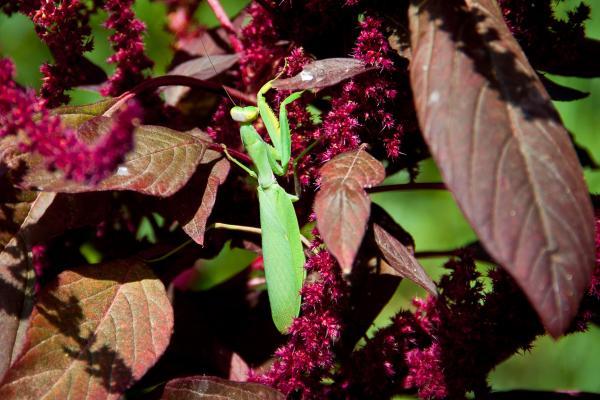
Figure 17–7. A praying mantis on an amaranth (Amaranthus sp). Mantises are ambush predators that eat crickets, grasshoppers, and frogs.
Nikolaj Potanin, Flickr CC BY-SA 4.0
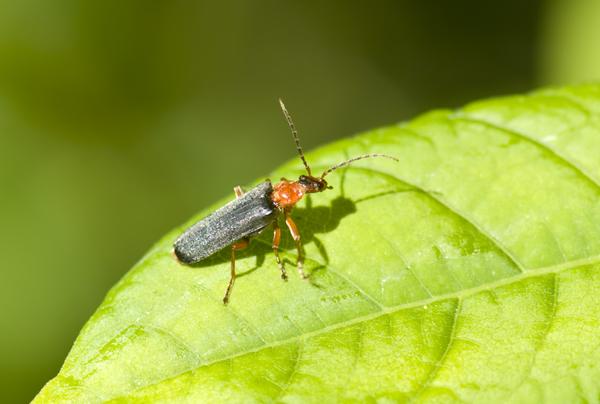
Figure 17–8. A soldier beetle on a Japanese knotweed (Reynoutria japonica) leaf. Soldier beetle larvae eat eggs and larvae of other beetles, moths, and other insects while adult beetles feed on aphids and other soft-bodied insects.
Cheryl Moorehead, Flickr CC BY 2.0

Figure 17–9. A braconid wasp on rambling dock. Braconid wasps are parasitoids or parasites that kill their hosts, which include aphids, beetles, caterpillars, squashbugs, and stinkbugs.
John Tann, Flickr CC BY 2.0
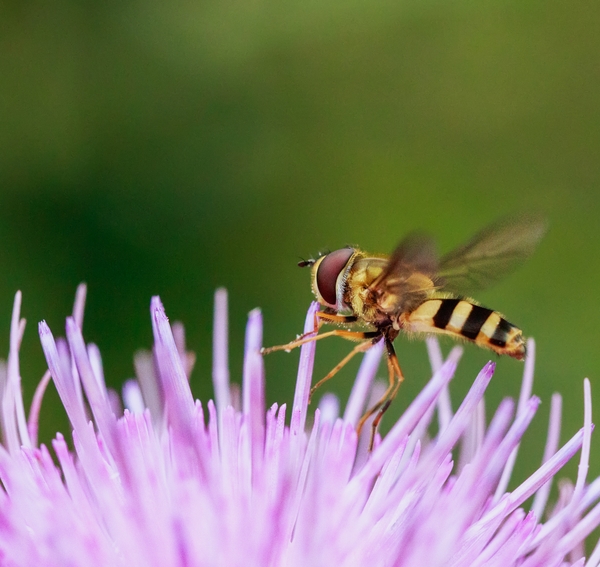
Figure 17–10. A syrphid fly, resting on a thistle blossom. Syrphid fly larvae feed on aphids, scales, thrips, and caterpillars, while the adults are important pollinators.
Shenandoah National Park, Flickr CC0

Figure 17–11. A bumblebee pollinating a creeping Charlie weed (Pilea nummulariifolia).
Bob Peterson, Flickr CC BY 2.0

Figure 17–12. A trap crop—goldenrod (Solidago sp.)—is attracting aphids so they stay away from garden vegetables.
rockerBoo, Flickr CC BY-SA 2.0
_ccbysa30.jpg)
Figure 17–13. Nettles (Urtica dioica) spread via its creeping, connected roots called rhizomes.
Rasbak, Wikimedia CC BY-SA 4.0

Figure 17–15. Fescue grass works well planted between garden beds because it does not spread.
Kathleen Moore CC BY 2.0

Figure 17–16. Oats (Avena sativa) are sown in February or March. After the corn is harvested in June the oats grow as a cover crop until the next planting season.
Allan Manson, Wikimedia CC BY-SA 4.0
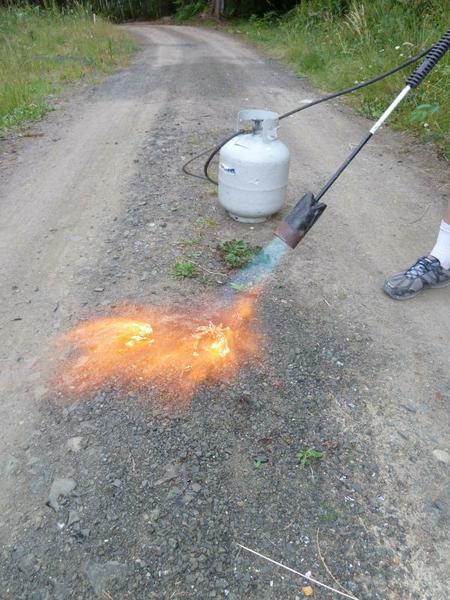
Figure 17–17. A hand-held propane gas burner used for weed management in a gravel driveway. Exercise caution and always carry a bucket of water.
Kathleen Moore CC BY 2.0
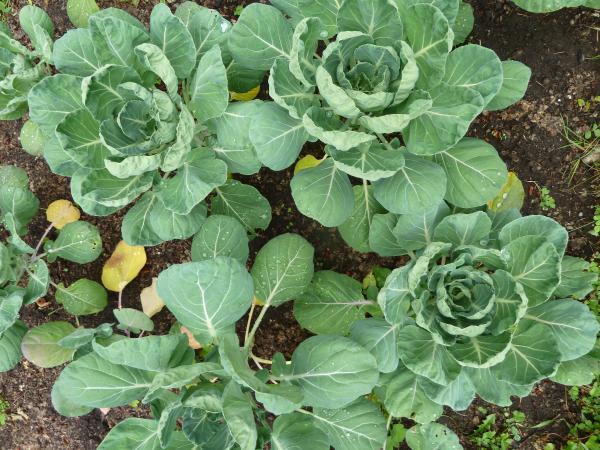
Figure 17–18. These Brussels sprouts were planted close together so their canopy shades out weeds.
Kathleen Moore CC BY 2.0
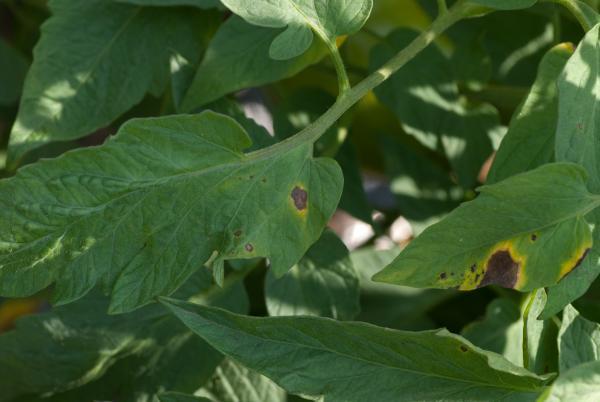
Figure 17–19. Tomato early blight is caused by a fungus, Alternaria solani, that overwinters in the soil.
Dwight Sipler, Flickr CC BY 2.0

Figure 17–23. A beneficial parasitic wasp laying eggs on a tomato horn worm.
Connie Schultz CC BY 2.0
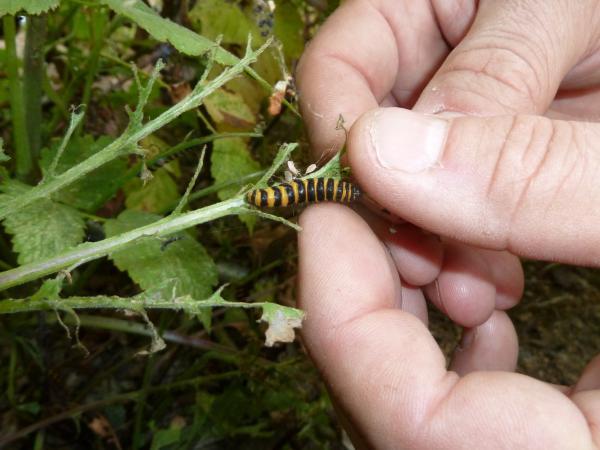
Figure 17–24. Hand-picking large insects like caterpillars and throwing them in a bucket of soapy water is an effective physical management technique.
Kathleen Moore CC BY 2.0
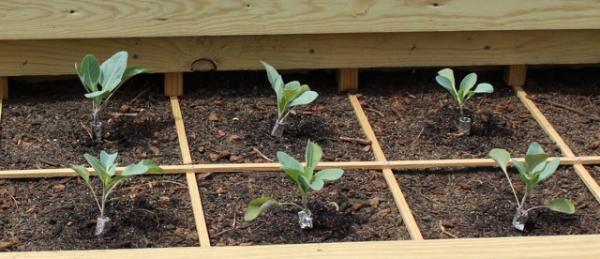
Figure 17–28. Cutworm collars constructed out of foil to protect cabbage seedlings.
Karen Jevsevar CC BY 2.0
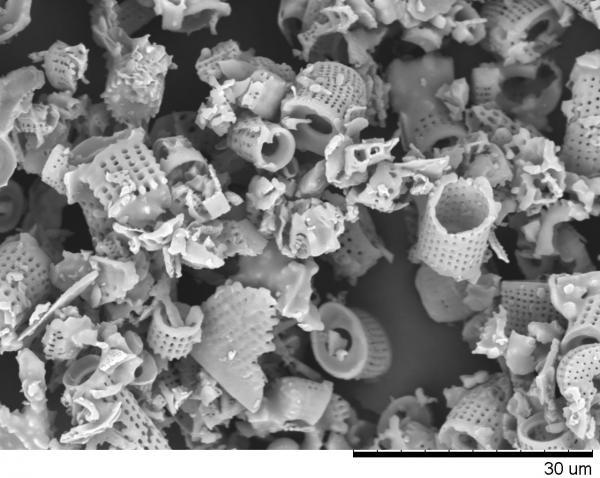
Figure 17–29. A scanning electron microscope image of diatomaceous earth showing the sharp edges that get in between insects exoskeleton and cause them to dry out and die.
Dawid Siodłak, Wiki Commons CC BY-SA 4.0
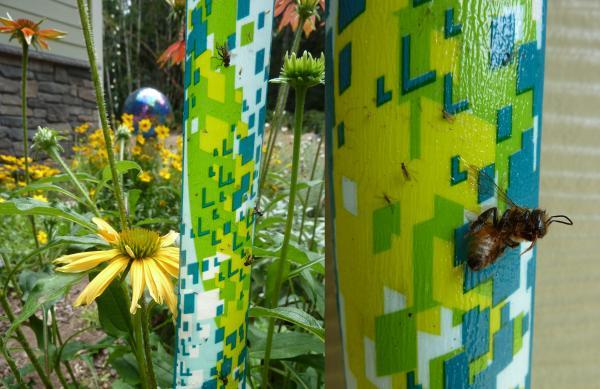
Figure 17–31. A sticky trap can help monitor insect populations as well as disrupt the life cycles of certain pests by catching flying or jumping forms. Be aware that sticky traps are indiscriminate. A honey bee flew too close (right).
Kathleen Moore CC BY 2.0
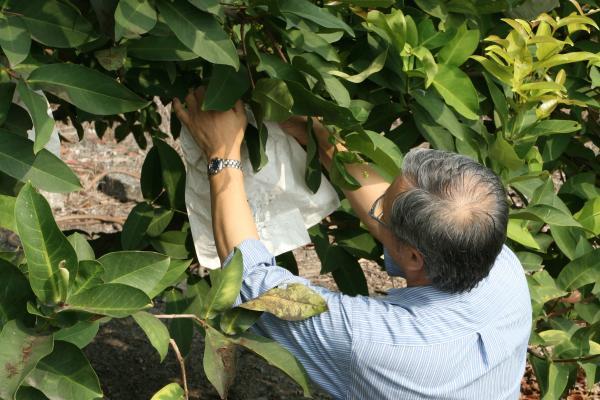
Figure 17–32. Wrapping fruit in individual cloth bags can be time consuming but worth protecting the fruit from insects, birds, or mammal predators.
Jim Epler, Filckr CC BY 2.0
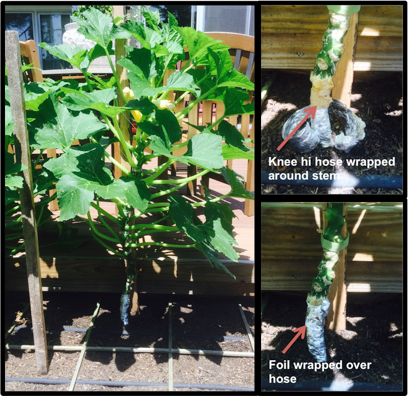
Figure 17–33. This squash plant has its stem wrapped in nylon stockings and foil to protect from vine borers.
Karen Jevsevar CC BY 2.0

Figure 17–34. Kaolin clay on a pear provides a barrier that prevents insect damage and sun burn.
Kathleen Moore CC BY 2.0
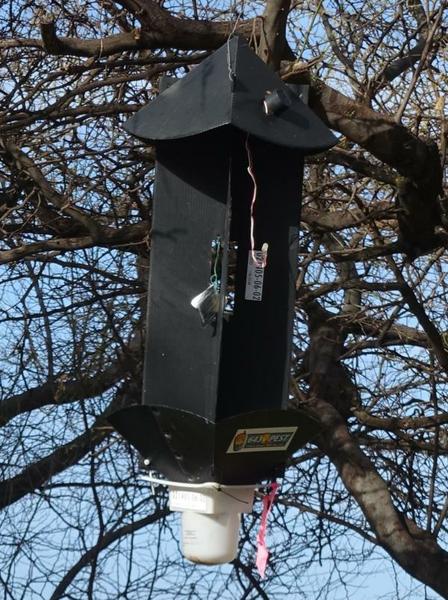
Figure 17–35. This trap uses chemicals that mimic insect pheromones and also has a solar-powered light to attract insects.
Scot Nelson, Flickr CC BY 2.0
Record Keeping
Record keeping is critical in evaluating the success or failure of any activity. Garden size, crop rotation, fertilization source and rate, pest management (including insects, diseases, and weeds), and postharvest garden sanitation are all practices to monitor and record throughout the season. See Appendix A, “Garden Journaling,” for more information.
Summary
Organic gardeners strive for a biologically balanced ecological system containing diverse insects, microorganisms, animals, and plants. By carefully nurturing the soil environment with proper cultural practices, enhancing biodiversity, and managing problematic weeds, insects, and diseases, organic gardeners maintain thriving and attractive landscapes. These healthy landscapes have a minimized need for the use of synthetic fertilizers and pesticides.
The transition from conventional to organic and sustainable practices includes learning to read the soil environment to identify if a site requires more frequent irrigation, soil amendments, mulching, or other practices. Selecting disease-resistant, climate-adapted cultivars and being aware of appropriate planting times further boost plant health. A final recommendation is to become familiar with common insect pests and diseases for the plants in the garden to stay a step ahead of potential problems.
Gardeners have various levels of commitment when gardening organically. Initially, it may require greater inputs of time to learn how to identify and address the needs of the landscape in new ways. Take time and set reasonable goals to avoid becoming overwhelmed. After a yearly organic maintenance routine is established, a successful and thriving organic garden is the reward.
Case Study—Think IPM: Dead Lettuce Seedlings
Your lettuce seedlings have died, and you are wondering what is causing this and if there is anything you can do to prevent it.
Review the five IPM steps summarized in this section and the diagnostic procedures from chapter 7, "Diagnostics:"
- Monitor and scout to determine pest type and population levels.
- Accurately identify host and pest.
- Consider economic or aesthetic injury thresholds. A threshold is the point at which action should be taken.
- Implement a treatment strategy using physical, cultural, biological, or chemical management, or combine these strategies.
- Evaluate success of treatments.
1. Monitor and scout to determine pest type and population levels.
You have planted lettuce in this raised bed for the past three years, and it has grown fine. This year, after one week in the ground, all but a few of the seedlings have died. There is no evidence of insects. A sample could be sent to a diagnostic lab to determine which disease might be causing this, but a more cost-effective approach requires digging a little deeper to reach the root of the problem.
2. Accurately identify pest and host.
After looking at the seed packet and reference books and reviewing the Lettuce Horticultural Information Leaflet from NC State, you confirm that you have the Romaine lettuce ‘Romulus’. Reading about disease problems with lettuce, you see damping off is a serious fungal disease that affects seedlings.
The following steps and questions from chapter 7, "Diagnostics," will help you accurately identify the problem. Responses are included in italics.
Step 1. Identify the plant: Romaine lettuce (cultivar ‘Romulus’).
Step 2. Describe the problem: All but about five of my 40 lettuce seedlings have died after a week in the ground. There is a fuzzy whitish mold on the top of the soil in some spots.
Step 3. Identify what is normal:
What does the healthy part of the plant look like? The healthy seedlings are bright-green and have held their shape.
Have you had a soil test? Yes, and I have amended my garden soil with compost and bone meal. (For information on how to submit a soil test, see chapter 1, “Soils and Plant Nutrients.”)
Step 4. Cultural practices:
Describe the age and history of plant: The seedlings are a week old. I have planted lettuce in this bed for the past three years.
Irrigation: It is watered twice a day for about 5 minutes.
Fertilizer: I amended the soil beds before I planted with compost and bone meal.
Maintenance: I have been diligent about keeping weeds out of the bed.
Step 5. Environmental conditions:
Are there any significant water issues? It has not rained for three and a half weeks, and it has been very hot for the past two months. There is never any standing water when it rains.
Describe the light near this garden bed. How many hours of sunlight? This bed gets about 5 hours of full sun a day.
Describe any recent changes or events: None that I can think of.
Step 6. Signs of pathogens:
On the leaves: No insects are visible; no pathogens are visible on the leaves.
On the roots: No insects are visible; no pathogens are visible on the roots.
On the soil: There are fuzzy white patches on the soil.
Step 7. Symptoms of pathogens:
On the leaves: Some of the leaves are yellow-brown.
On the stems: Stems are shrunken and black and appear almost girdled.
On the roots: Roots are brown and slimy.
Step 8. Distribution of damage in the landscape:
Are other plants in the landscape affected? No other vegetables in the garden are affected.
Step 9. Distribution of damage on the plant and specific plant parts:
Where is the damage seen on the plant? On the aboveground and belowground portions of the plant.
Step 10. Timing:
When did you notice this problem? This morning when I went out to water. The seedlings were fine yesterday.
Steps 6 and 7 lead us to believe we are dealing with a pathogen. Steps 2, 4, 5, 9, and 10 support our theory that this is damping off.
3. Consider economic, aesthetic, and injury thresholds.
The lettuce is a small part of your overall vegetable garden, and you have other lettuce varieties planted in different locations. You do not wish to have this problem in the future, so the disease is severe enough to warrant investigation.
4. Implement a treatment strategy using physical, cultural, biological, or chemical control, or combine these strategies.
From the information found by searching “damping off + NCSU or Extension” on the internet, you learn damping off is a fungus and its spores are naturally present in the soil. It is a common disease of many seedlings but is often a problem when seeds are sowed indoors. Because the fungus is naturally occurring in the soil, there is no way to get "rid" of the fungus. There are, however, many ways to manage it effectively.
Physical. This fungus is most problematic when humidity and temperatures are high, and air moves poorly. Growing seedlings in a cool, well-ventilated greenhouse helps. Thin seedlings so there is good air movement around them. Rotating crops so the same crop is not grown in the same bed stops the buildup of this fungus.
Cultural. Letting soil dry out between watering and not watering on cool sunless days helps keep damping off spores at bay. Heating soil in an oven before sowing seeds may kill off the spores. Covering the seeds with compost or sphagnum moss may also help.
Biological. There are no known biological treatments for damping off.
Chemical. Sulfur powder has been shown to be effective at treating small areas and preventing this fungus from spreading.
5. Evaluate treatment success.
You decided to rotate the lettuce out of this bed and not plant it there again for at least four more years. You heat your soil medium in the oven before starting any seedlings now, and you make sure the windows on your greenhouse allow for good airflow. You are careful to thin out seedlings and water them thoroughly, but you let them dry out before watering again. You started a garden journal to keep track of the rotation of crops in your garden so you have records to look back on when future problems occur.
Frequently Asked Questions
1. Are all animal manures safe for organic gardens?
Manure from vegetarian animals is generally recommended because it composts faster and has less nitrogen. Fresh manures are very high in nitrogen, so composting the manure rather than applying it directly is recommended. Mixing the high nitrogen compost, which is “green,” with some “browns,” such as dried leaves, straw, or untreated sawdust, makes balanced compost. The microbes present and the nitrogen content of the manure heats up your compost pile quickly. Keep your pile at 140˚F for several days to kill weed seeds. The National Organic Program (NOP) specifies that all manures are spread 120 days or more prior to harvest to reduce pathogens. Beware of using manure from animals that have been fed on hay grown in a field where persistent broadleaf herbicides were used to manage weeds. The herbicides can persist through the animal’s digestive tract and through the composting process and kill plants where the compost is applied.
2. How do I start a vegetable garden on a former lawn without using chemicals?
Smother the grass by laying wet, uncoated cardboard or several layers of newspaper on the ground, making sure to overlap any seams. On top of the cardboard or newspaper start layering organic material, such as compost, straw, leaf mulch, shredded paper, sawdust, or other organic material. Plant your seedlings by placing potting mix in the planting holes. Or if seeding crops, put a 1-inch to 2-inch layer of potting soil on top of your beds. Another option is to wait for the bed to compost over the next year and then plant directly in the amended soil.
Further Reading
Bowe, Alice. High-Impact, Low-Carbon Gardening: 1001 Ways to Garden Sustainably. Portland, Oregon: Timber Press, Inc., 2011. Print.
Bradley, Fern Marshall, ed. Rodale's Garden Answers: Vegetables, Fruits, and Herbs: At-A-Glance Solutions for Every Gardening Problem. Emmaus, Pennsylvania: Rodale Press, Inc., 1995. Print.
Damping-off in Flower and Vegetable Seedlings, NC State Extension Horticulture Information Leaflet) 0DN-14.
Deardorff, David, and Kathryn Wadsworth. What's Wrong with My Plant? (And How Do I Fix It?): A Visual Guide to Easy Diagnosis and Organic Remedies. Portland, Oregon: Timber Press, Inc., 2009. Print.
Hanson, Beth, ed. Natural Disease Control: A Common-sense Approach to Plant First Aid. Brooklyn, New York: Brooklyn Botanic Garden, 2001. Print.
Lettuce, NC State Extension Horticulture Information Leaflet.
Chapter Text Hyperlinks
National Organic Program Regulations homepage USDA
Organic Materials Review Institute homepage
The Myth of Soil Amendments Part II: "If you have a clay soil, add sand to improve its texture," Washinton State University
Soil Testing homepage – NCDA&CS Agronomic Services
“Understanding the Soil Test Report” USDA
Corn Gluten Meal Research Page, Iowa State University, Department of Horticulture
OMRI Products and Materials Lists
Crop Rotations On Organic Farms, Center for Environmental Farming Systems [CEFS]
Lettuce, NC State Horticulture Information Leaflet
For More Information
NC State Resources
- Composting on Organic Farms, AG-659-01
- Cover Crops for Organic Farms, AG-659-03
- Crop Rotations On Organic Farms, Center for Environmental Farming Systems [CEFS]
- Damping-off in Flower and Vegetable Seedlings, ODN-14
- Herbicide Carryover in Hay, Manure, Compost, and Grass Clippings
- NC Organic homepage & blogspot
- Organic Grains, N.C. Cooperative Extension
- Organic Fire Ant Management
- Permaculture Organic Farming Course with Dr. Will Hooker (36 videos)
- Soil Fertility on Organic Farms, AG-659-06
- Soil Quality Considerations for Organic Farmers, AG-659-04
More NC State Resources
Other Resources
- ATTRA, National Sustainable Agriculture Information Service
- Corn Gluten Meal Research Page, Iowa State University, Department of Horticulture
- National Organic Program Regulations homepage USDA
- OMRI Products and Materials Lists
- Organic And Biological Control Of Plant Diseases, by Pennsylvania State University
- Organic Materials Review Institute homepage
- Pesticide Ingredients Fact Sheets, National Pesticide Information Center
- Soil Biology Primer, USDA Natural Resources Conservation Service
- Soil Solarization for the Control of Nematodes and Soilborne Diseases, ANR-713, by Alabama A&M and Auburn Universities
- Using Organic Fungicides, by Purdue University
Contributors
Authors:
Aimee Colf, NC State Extension, Anson County
Lucy Bradley, Associate Professor and Extension Specialist, Department of Horticultural Science
Frank Louws, Professor and Extension Specialist, Department of Plant Pathology
David Orr, Associate Professor, Department of Entomology
Contributions by Extension Agents: Paul McKenzie, Cyndi Lauderdale, Danny Lauderdale, David Goforth, Colby Griffin
Contributions by Extension Master Gardener Volunteers: Deborah Green, Bethany Sinnott, Karen Damari, Connie Schultz, Lee Kapleau, Katie Maynard
Content Editors: Lucy Bradley, Associate Professor and Extension Specialist, Urban Horticulture, NC State University; Director, NC State Extension Master Gardener programKathleen Moore, Urban Horticulturist
Copy Editor: Barbara Scott, Debbi Braswell
How to cite this chapter:
Colf, A., L.K. Bradley, F. Louws, and D. Orr. 2022. Organic Gardening, Chapter 17. In: K.A. Moore, and L.K. Bradley (eds). North Carolina Extension Gardener Handbook, 2nd ed. NC State Extension, Raleigh, NC. <http://content.ces.ncsu.edu/17-organic-gardening>
Publication date: Feb. 1, 2022
AG-831
Other Publications in North Carolina Extension Gardener Handbook
- 1. Soils & Plant Nutrients
- 2. Composting
- 3. Botany
- 4. Insects
- 5. Diseases and Disorders
- 6. Weeds
- 7. Diagnostics
- 8. Integrated Pest Management (IPM)
- 9. Lawns
- 10. Herbaceous Ornamentals
- 11. Woody Ornamentals
- 12. Native Plants
- 13. Propagation
- 14. Small Fruits
- 15. Tree Fruit and Nuts
- 16. Vegetable Gardening
- 17. Organic Gardening
- 18. Plants Grown in Containers
- 19. Landscape Design
- 20. Wildlife
- 21. Youth, Community, and Therapeutic Gardening
- Appendix A. Garden Journaling
- Appendix B. Pesticides and Pesticide Safety
- Appendix C. Diagnostic Tables
- Appendix D. Garden Tools
- Appendix E. Season Extenders and Greenhouses
- Appendix F. History of Landscape Design
- Appendix G. Permaculture Design
- Appendix H. Community Gardening Resources
- Appendix I. More NC State Resources
- Glossary
N.C. Cooperative Extension prohibits discrimination and harassment regardless of age, color, disability, family and marital status, gender identity, national origin, political beliefs, race, religion, sex (including pregnancy), sexual orientation and veteran status.



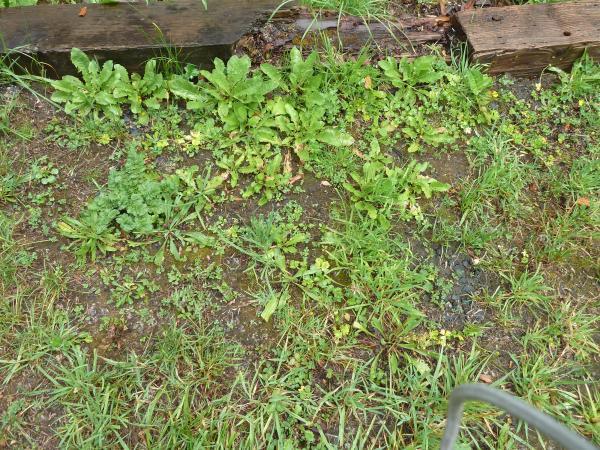
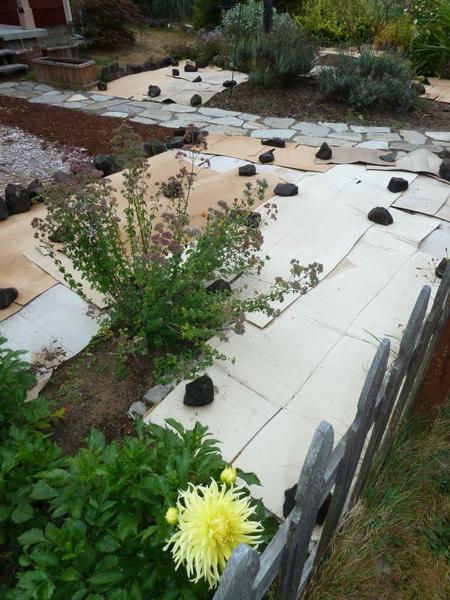

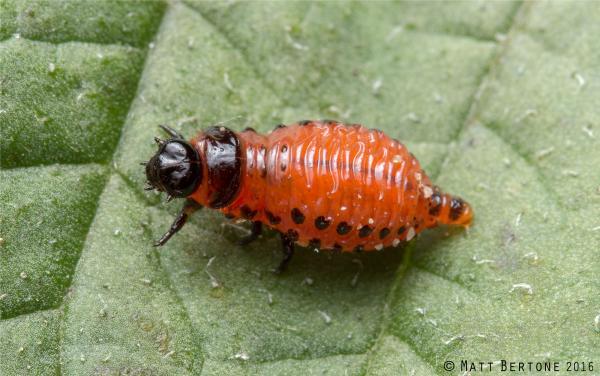

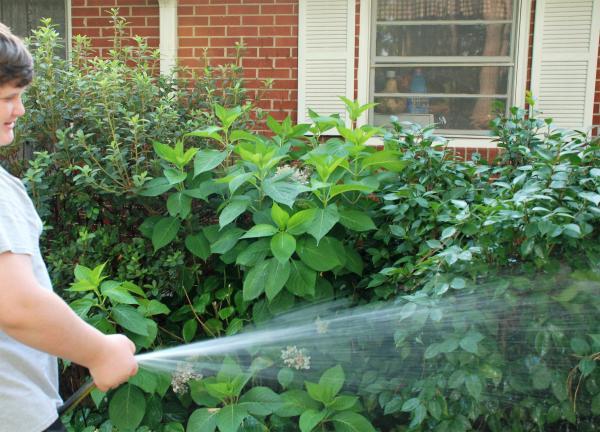
.jpg)
